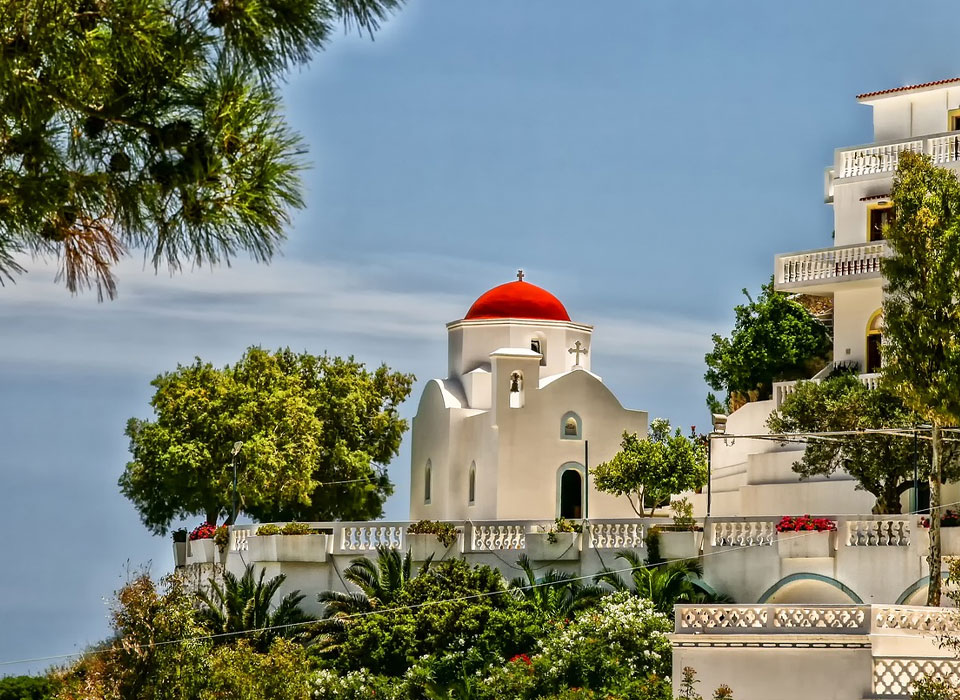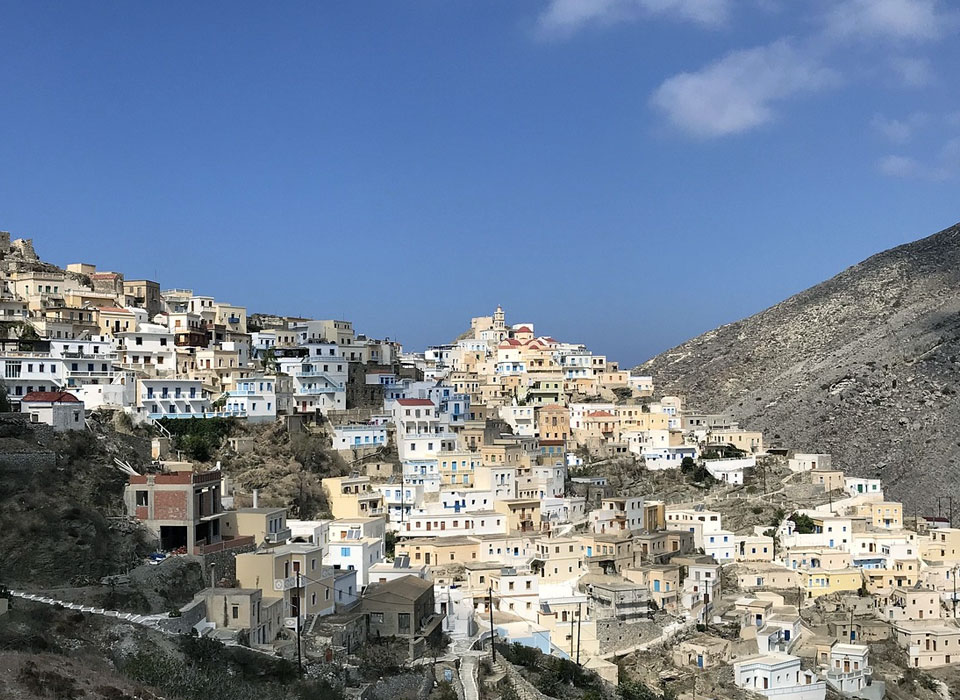Some information about Karpathos...
Karpathos, an island ideal for peaceful vacations, has an exceptional landscape beauty, due to the fact that it pulses with picturesque beaches and has many morphological alternations, as the southern part is plain while the central and the northern part are mountainous, composing a peculiar but interesting icon. The island of Karpathos belongs to the Dodecanese Islands cluster and it located at the southern part of the cluster, very close to the island Kassos.
Karpathos covers an area of 302 m², has a coastline of 160 km and has 6.500 inhabitants. The highest mountain of the island, Kali Limni, is 1.215 meters high. Karpathos or Pigadia is the capital and the main port of the island where the imposing rock with the ruins of the acropolis prevails. At this beautiful settlement with the traditional houses you will also see the church of Agia Kyriaki, the ruins of the paleochristian basilica of Agia Fotini, the pine forest and the cave of Poseidon.
Apart from the capital, the island of Karpathos comprises of numerous other interesting settlements. Ammoopi, Makris Gialos and Lefkos, three tourist resorts with amazing beaches, Aperi, the old capital that is a cultural settlement with many sightseeing and Arkassa, an impressive settlement of natural beauty, are worth visiting.
The amphitheatrically built and picturesque village Menetes, Messohori, which is hanging above the sea offering superb view to the sunset and the sea, as well as Othos and Olympos, two traditional mountainous villages in the heart of the untamed scenery, shall definitely enchant you.
For swimming we would advise you to visit the gulf of Pigadia, Apella, Agios Nikolaos, Agios Minas, Ammoopi, Makris Gialos, Lakki, Fokia, Ahata, Kyra Panagia, Diafani, Vanada, Afiartis, Lefko, which are all exceptional places for swimming and sunbathing.
Explore the magnificent island of Karpathos and relish an unforgettable experience!



Karpathos is a magical paradise for every visitor all year round... We challenge you come and find out... We will take care of your stay...
A welcoming island rich in history… an island where you can enjoy and combine everything…
History of Karpathos
Neolithic Period
The earliest traces of human presence on the island of Karpathos date back to the end of the Neolithic Period (4,000-3,000 B.C.). The first inhabitants are believed to have come from Asia Minor, related to the Pre-Greek peoples who lived in Crete and other Greek islands, such as the Carians.
The primitive Neolithic civilization of Karpathos continued into the 3rd millennium B.C. Around 2000 B.C., Minoan settlers from Crete brought new vitality and economic prosperity to the island.
Neopalatial Period
During the Neopalatial Period of Crete (approximately 1700-1450 B.C.), also known as the "Era of Minoan Thalassocracy and Minoan Colonization," Karpathos acquired a distinctly Minoan character, with significant population and economic development. The historian Diodorus Siculus mentions that the first inhabitants of Karpathos were Cretans, sent as settlers by King Minos.
Later, settlers from Argos, led by Ioclus, son of Demoleon, settled on the island.
Homeric Years
Both Homer and archaeological evidence confirm the presence of Achaeans (Mycenaean Greeks) on the island, maintaining the Minoan character of the culture until the end of the Bronze Age. Karpathos participated in the Trojan War under the command of the Heraclids Phidippus and Antiphus.
Archaic Period
There are no records of the island's fate from the end of the Bronze Age until the Archaic Period. The Dorian population seems to have dominated the island, and the four cities mentioned by Strabo may have existed from the Archaic Period, if not earlier.
In antiquity, as well as until recently, Pigadia was the port of the city of Karpathos (modern Aperi) and was called Poseidion. The other three cities were Arcesia (near modern Arkasa), Brykous (modern Vrykounda), and Nisyros, possibly located at the modern Palatia of Saria. Saria was independent of Karpathos in antiquity and was called Saros.
After 478 B.C., Karpathos became a member of the First Athenian League, as evidenced by the tributes paid by its cities to the Allied treasury. In 404 B.C., at the end of the Peloponnesian War, it submitted to the Spartans, but after the Battle of Cnidus (394 B.C.), it returned to Athenian control and later became a member of the Second Athenian League.
Classical-Hellenistic Period
During the Classical and Hellenistic Periods, Karpathos was economically vibrant and culturally flourishing, largely due to the cultural and economic relations it developed with the cities of Rhodes, particularly Lindos. The main city of the island was likely Karpathos, probably located in modern Aperi, which continued to be the capital of Karpathos in later years.
Roman Period
With its submission to the Romans, Karpathos gained strategic significance, becoming one of the three major naval bases of Rome in the Mediterranean. This strategic position was maintained under the Byzantine Empire, with sources noting that the ships from Karpathos' naval base led Nikephoros Phokas to Crete in 961 A.D.
Under Diocletian (284-305 A.D.), it was part of the "Province of the Islands" (Provincia Insularum) and under Heraclius (610-641), it was part of the Theme of Crete.
Pirates
Three centuries (mid-7th to mid-10th century A.D.) of decline and desertion followed, with pirates from North Africa and Asia spreading terror and destruction to coastal settlements, which were abandoned. In their place, medieval mountain villages developed, which remain to this day.
Between 1204 and 1312, Karpathos was the subject of competition among Byzantines, Genoese, Knights Hospitaller, and Venetians, with the Venetians ultimately prevailing. The Venetians, led by Andrea Cornaro, remained rulers of Karpathos and Kasos until 1538, when Hayreddin Barbarossa captured the islands for the Turks.
Ottoman Period
During the Ottoman period, Aperi continued to be the capital of Karpathos until 1892, when Pigadia took over as the capital. In 1821, Karpathos revolted and participated in the struggle for independence. However, at the end of the revolution, it remained, along with the other Dodecanese, part of the Ottoman Empire.
In 1912, the Turkish occupation was succeeded by the Italian occupation. In 1944, the people of Karpathos rose up against the Italians and called in the British allies, who occupied the island. In March 1948, Karpathos, along with the rest of the Dodecanese, was incorporated into Greece.
